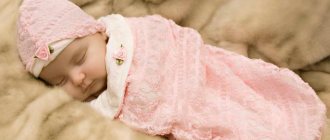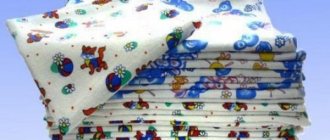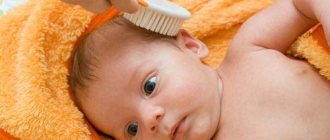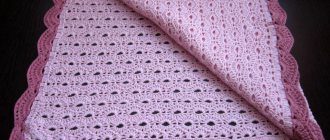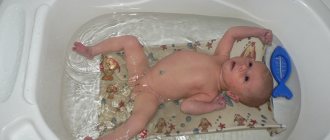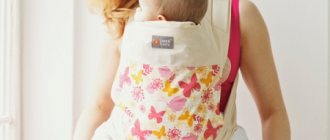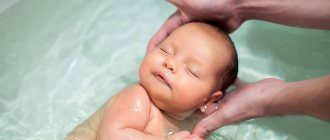Should I swaddle my baby?
Not so long ago, the question “to swaddle or not” was not raised at all. The newborn was taken from the maternity hospital in the form of a swaddled little bag, because that was the custom and custom. The rules on how to swaddle children have been passed down from generation to generation. Young mothers stubbornly followed the canons of that era, learning from their elders the correct method of swaddling a baby.
Nowadays, views on many things concerning children have changed, so the decision on the need to swaddle a particular child remains with his parents and the observing pediatrician.
Swaddling will be indicated for restless babies who are clearly more comfortable in a confined space that reminds them of the period of being in their mother's belly. A newborn who wakes himself up every now and then by throwing up his arms, gets scared and cries will probably perceive swaddling favorably, and his parents will be able to worry less about the baby.
Blanket
How to properly swaddle a baby in a warm blanket? In winter, babies are wrapped directly in a warm blanket for walks outside. Consider the following methods:
- regular swaddling;
- with a "head".
The procedure for swaddling “with your head”:
- Place the blanket at an angle.
- Place your baby in the center of the blanket.
- Tuck the left edge of the blanket behind your baby's back.
- You need to make a fold on top of the left edge: one edge of it is under the baby’s chin, and the second is near the navel.
- Lift the bottom corner of the blanket and tuck it under the fold.
- Fold the right corner of the blanket behind the baby's back and secure the resulting envelope with a bow.
In spring/autumn, you can wrap the baby in a blanket with the head open (put a cap on it). The technique looks like this:
- We place the blanket on the table, as in the first case.
- Make a fold on the outside.
- We position the child so that the head is above the fold.
- We wrap the left edge of the blanket under the back.
- Wrap the legs in a blanket.
- Fold the right edge over and secure it with a bow.
This envelope is good because at any time you can straighten the fold and cover the child’s head with a blanket.
Pros and cons of swaddling newborns
Let's look at the main positive and negative aspects associated with swaddling a baby.
The benefits of swaddling
- Swaddling makes it easier to fall asleep and makes the sleep itself more restful, and therefore longer. The baby will probably sleep longer if he is swaddled than if he is not swaddled (provided that the baby is dry, warm and not hungry).
- The newborn feels safe in such a cocoon created by the diaper, associating it with the world in which he lived before birth.
- The “wide swaddling” method serves as a prevention of hip dysplasia, but is used only on the recommendation of a specialist.
- Some parents find it much easier to change a diaper than to change into modern bodysuits and slips.
- When a baby is swaddled, the head is most often fixed a little too. This is very helpful for young parents who, due to inexperience, may forget to hold the child’s head.
Minuses
- “Tight swaddling” interferes with the physiological development of infants’ limbs, creating various pathologies. This technique is not recommended and is almost never used on a regular basis these days.
- The risk of overheating is slightly higher if you swaddle your baby. Of course, you need to think about what the baby will wear and how thick and dense the diaper is used to avoid this. It is important to remember that in such a “cocoon” the temperature is higher than in its absence and free air circulation around.
- Excessive swaddling can affect the physical development of the child. It is not recommended to swaddle during the waking period; children should be given freedom for active movements.
What is the benefit of such swaddling?
- Comfort for the child and the ability to take a natural position while sleeping. The space is clearly limited, but without the “straitjacket” effect of tight swaddling - the baby is calm internally and physically comfortable.
- Tactile sensations. The baby can feel the diaper fabric with both arms and legs. Which contributes to the development of the sense of touch.
- The baby can sleep on his side and even on his tummy.
- The child develops correctly (fine motor skills, tactile sensations, etc.).
- The baby begins to walk earlier.
- There is less inflammation and irritation on the baby's skin, thanks to free air circulation and maintaining normal temperature inside the diaper, without overheating and the greenhouse effect.
- The lungs work in full, blood circulation is not impaired, the blood is fully saturated with oxygen.
- Free swaddling is the first stage of hardening and, accordingly, strengthening the immune system.
Types of swaddling
It turns out that you can also swaddle a baby in different ways, and in the modern world there are even special devices for those who have not fully mastered this skill.
Tight swaddling
The diaper wraps tightly around the baby's body: the arms are pressed to the body, the legs are fixed (there are options when they can swaddle the head). This method significantly complicates any movement of the child.
Tight swaddling was actively used earlier and was accepted everywhere, because it was believed that this way the newborn sleeps better and develops correctly. Modern science says otherwise.
This method is not physiological for a newborn, therefore it leads not only to psychological discomfort, but can also provoke disturbances in physical development.
Free swaddling
This method has two subtypes: classic with fixation of handles and without.
In the first case, all the limbs end up in a kind of envelope, inside which the newborn will move them, but will no longer be able to pull them out. For such swaddling, the baby’s arms are not extended along the body, but are often crossed on the chest, as this is more physiological. The legs remain in a free position.
In the second option, only the lower limbs need to be swaddled, forming a “bag” for sleeping. At the same time, motor activity is not particularly limited, because the fixation is very easy. The newborn's arms and chest remain open.
Wide swaddling
Wide swaddling is used when a newborn has problems in the correct formation of the hip joints (underdevelopment of the hip joint, dysplasia, etc.), that is, according to indications from a doctor. The peculiarity of this type of fixation is that the child’s legs take the pose of a “frog” or the letter “M”.
To swaddle a baby using this method, you need to place a roll of several diapers between the legs, give the baby’s limbs the desired position, and only then secure them. The handles are left free.
Primary requirements
Proper swaddling of a baby has a number of positive aspects:
- It facilitates the baby’s adaptation to new living conditions outside the mother’s womb, in which he was warm and comfortable. The diaper, tightly covering the body of the newborn, seems to return him to the cramped conditions of the mother's womb. That is why a baby wrapped in it calms down and falls asleep faster.
- A warmed soft diaper, replacing the warmth of the mother's body, helps the baby's body adapt to new temperature conditions.
- Once born, the little man experiences severe stress. He often shudders in his sleep, flaps his arms and, touching his face, wakes up. This is exactly what happens to newborns whose arms and legs are left free. If you swaddle the baby, this will not happen and his sleep will be more restful.
Full swaddling
Pediatricians are inclined to believe that swaddling is beneficial for newborns during the first four weeks of their life. With the help of diapers, adaptation to the “new” world will be more harmonious and gentle for babies.
Having become somewhat accustomed to the environment, the baby will lose the habit of reflexively throwing up his limbs, and their movements will become more smooth and coordinated. There is no longer any special need for swaddling a one and a half month old baby. There is a point in night swaddling only for those babies who continue to throw up their arms during sleep.
Free swaddling technology
Since the method of freely swaddling children is the most correct, from the point of view of physiology, and preferable at this stage of the development of science, we will use its example to consider the technology of this process.
We will need a clean diaper measuring 0.9 by 1.2 m.
Lay it out on the changing table or surface where you want to swaddle your newborn. We turn the upper edge, where the head will be, slightly inward to make the place of contact with the skin less traumatic.
We place the baby on top of the diaper so that its upper edge is located under the head (approximately at the level of the back of the head). We slightly press one hand to the body or place it on the chest, pick up the corresponding free edge of the diaper, cover the baby with it from above and move the end behind the back. Similarly, we fix the other hand using the diaper remaining on the opposite side. Don't forget to do it loosely enough, not tightly.
To secure the legs, take the lower end of the diaper, wrap it slightly inward and throw it over the baby’s legs. Next, one by one we bring the corners of the diaper behind the back and straighten it. We fix the last free edge of the diaper by slipping it into the resulting pocket so that the finished bag does not unfold.
If you want to swaddle a newborn without arms, then the technology will be similar, excluding the first stage. It is better to take a slightly smaller diaper, or fold a larger one.
In this option, you need to place a diaper not under the back of the baby’s head, but at the level of the armpits and, raising your arms, swaddle according to the algorithm given earlier.
Disadvantages of the method
Numerous scientific studies confirm that tight swaddling is more likely to harm the baby. In this condition, it is impossible for the baby to take the usual fetal position, to roll over onto his stomach, and it is in this position that it is recommended to keep a child with colic.
Tight swaddling constricts the baby's chest and makes breathing difficult. When wrapping a newborn tightly in flaps of fabric, you need to consider the following:
- When dressing a newborn, you should not tighten body parts , as this impedes blood circulation. Constantly keeping the baby's straightened legs in a static position is fraught with dislocation of the hip joint.
- A consequence of difficult blood circulation is a lack of calcium. This element is absorbed by the body during physical activity. If the baby does not move its arms and legs, there is a risk of rickets .
- There is a hypothesis that swaddling has a negative effect on the child's psyche : the lack of freedom of movement in infancy creates a tendency towards submission. Consequence: a weak-willed personality is formed.
- Diapers serve as a means of protection from the cold. In modern apartments with central heating, this is more harmful than useful: there is a high risk of overheating the baby , especially if a diaper is used. Why swaddle newborns in such conditions, especially boys? In hot countries, there is no practice of wrapping a baby in many layers of cloth.
- For discerning parents, the modern clothing industry produces lines of beautiful clothing for babies; diapers are aesthetically inferior to suits and onesies . The latter take up less space during drying and storage and require a small amount of detergents.
- If the room is cold, there is a chance that the baby will break free from the constricting diapers and freeze . No matter how tightly you wrap a child, active children are able to find a way to get out of captivity.
- A newborn sleeps most of the day. Several weeks pass, and he begins to need to explore his surroundings, which swaddling prevents .
- The thermoregulation system in newborns is imperfect, but its safety margin is high. Children are born and live in hot countries and the Far North. even mild hypothermia can subsequently .
- You can put on a diaper in the crib, it is better to wrap the baby on a changing table, but buying one is an expensive pleasure .
We recommend reading: List of necessary things for a newborn for the first time
Changing accessories
A diaper is a classic attribute that is used for swaddling. However, now there are many other devices that help those mothers and fathers who have not fully mastered this skill to cope with the process.
Instead of a standard diaper or as an addition to it, the modern production of children's goods offers sleeping bags for newborns, diapers with Velcro and zippers, with closed and free handles. A lot of colors and materials in different price categories allow you to choose an option that suits you and your baby.
I would also like to mention the changing table or overhead mattresses for the crib. Such devices greatly simplify life for young parents, because the swaddling process takes place at a comfortable height, which means there is no unnecessary strain on the back.
It’s up to you to decide which swaddling method is correct and suitable for your child, because to decide, you need to try it. Some babies really gravitate to swaddling and feel better, pleasing their parents with good sleep and good mood. Of course, if swaddling a baby is more stressful for you, but the baby is comfortable as is, then there is no need to insist. A healthy baby who has no indication for wide swaddling will develop correctly and harmoniously, even without this process.
Selection of diapers
Diapers are made from various materials, the main characteristic of which is their 100% naturalness. When choosing suitable fabrics, consider the time of year and weather. For hot days, products made from chintz and calico are suitable, for cold times - from flannel, flannel.
Often, when it is cold, two diapers are used: a lower calico and an upper flannel. You can purchase more modern options: Velcro, zippers, envelopes.
Important! The number of diapers is determined by the time of use: at night or throughout the day.
Open face
Swaddling an open-faced baby in a rectangular blanket
- The blanket is laid out diagonally. The edge is folded inward. A fold line is created.
- We place the baby closer to the top line.
- We wrap the head with the top part of the blanket. Press along the ears.
- The edges straighten out. We wrap the right one around the child.
- Cover with the bottom.
- We turn it with the left side.
- We fix it.
In what situations is it necessary to swaddle a baby?
Despite the possible disadvantages of swaddling, in some cases it becomes necessary:
1. Poor sleep, frequent awakenings. 2. Constant crying while breastfeeding. 3. Frequent rolling in bed. 4. The need for medical and hygienic procedures (eye drops, ear cleaning, etc.). 5. The occurrence of diaper rash.
If you are faced with one of these problems, then be sure to read on to learn how to properly swaddle your baby.
Rules for choosing an envelope for discharge
Now you can find a large number of envelopes for discharge: from simple models to lace products. Envelopes for newborns come in the following types:
- Transformers . They are a small blanket or a comfortable blanket for discharge from the maternity hospital in the summer. Depending on the time of year they vary in density. The summer blanket envelope for discharge is an openwork diaper with a corner. If the baby was born in spring or autumn, then he will be warmer and more comfortable in a light fleece blanket or blanket. Such models of transforming envelopes have been popular for many years. Over time, only the type of material used and decoration changes.
- Envelope bag with a hard bottom . This is a modified modification of the previous model. The difference is an additional hard part in the form of a mattress made of coconut filler. These envelopes ensure the safety of the baby when moving and support the still unformed spine. The disadvantage of this model is that you need to carry the baby as if in a bag, with your hands down. For a festive discharge ceremony, the presented model is suitable in case of a long journey home. It makes no sense to buy such an envelope separately, because now modern strollers are equipped with an additional cradle.
- Overalls . It belongs to the most successful type of envelopes. With the help of simple manipulations with the zipper, the envelope is transformed into a comfortable overall. A feature is considered to be practicality and a longer period of use. If ordinary envelopes last up to four months of use, then the overalls can last until the baby is two years old. The disadvantage is the high cost and lack of summer options.
Wrapping a baby in a blanket is not at all difficult, and after a week the young mother will easily cope with the task. Ready-made envelopes for newborns and Velcro blankets, which are available in a large assortment in children's stores, will help make life easier for parents. Many modern parents prefer to do without all kinds of wrappings, purchasing attractive and warm overalls for their children, but in severe frosts, additional warmth from a blanket will not be superfluous.
Originally posted 2017-12-21 06:39:03.

